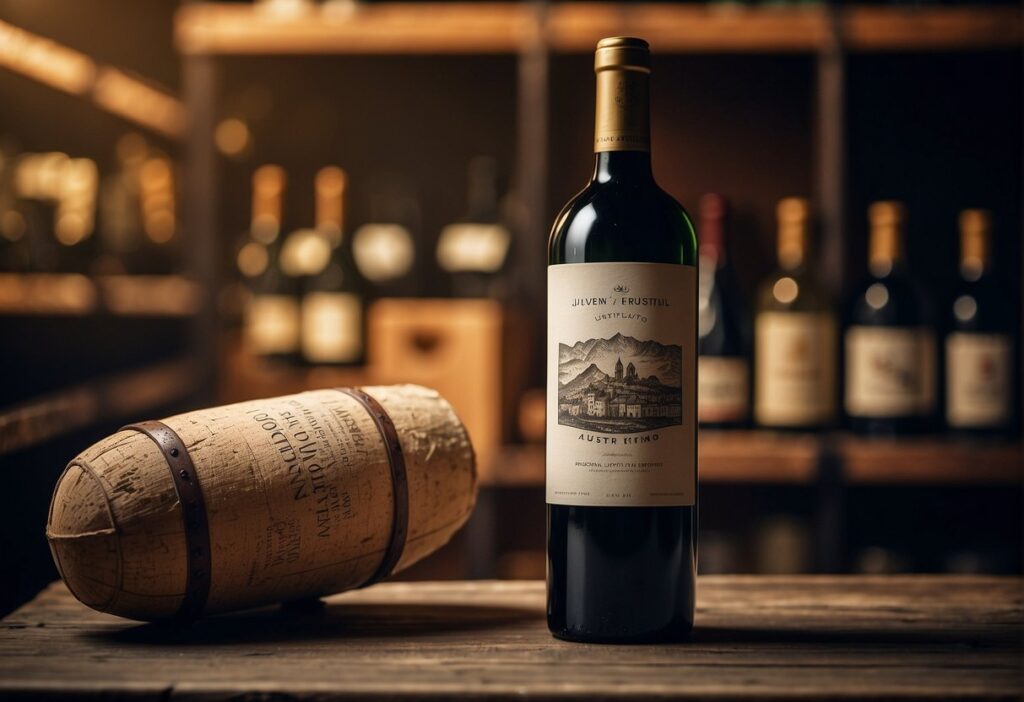Proper humidity control is essential for wine preservation. When storing wine, maintaining the right humidity levels ensures that corks don’t dry out and allow air to seep in. This helps the aging process, allowing wines to develop their full complexity. Keeping humidity between 60% and 70% preserves wine quality and prevents spoilage. This is crucial for anyone serious about wine storage.

Investing in a wine fridge with humidity control can make a significant difference. These fridges often come with built-in or manual options to maintain ideal humidity. It’s vital to understand how to adjust these settings to match the storage needs of your wine collection.
For tips on managing humidity in wine fridges, check out this comprehensive guide.
The balance between temperature and humidity is critical. Fluctuations can damage wine, leading to unpleasant changes in taste and aroma. Your storage method, whether a wine cellar or cooler, needs careful attention to detail. Prioritizing these aspects ensures your wine remains in peak condition.
The Importance of Humidity in Wine Storage
Humidity control is essential in a wine cellar to preserve wine quality and prevent spoilage. Maintaining ideal humidity levels between 50% and 70% is crucial for protecting cork integrity while avoiding conditions that lead to mold growth.
Effects of Humidity on Cork and Wine Quality
When storing wine, the condition of the cork plays a vital role. Cork integrity is at risk if humidity is too low, as dry corks start to crack. This allows unwanted air to enter the bottle, which can lead to oxidation. Oxidation negatively impacts wine quality, altering flavors and aromas.
Higher humidity levels, around 60% to 70%, are crucial for keeping corks moist. By doing so, you ensure a proper seal that protects your wine. Maintaining this balance helps wine age correctly, preserving both its taste and quality.
Preventing Mold Growth and Wine Spoilage
While maintaining adequate humidity is vital, excessive moisture can cause problems. Humidity above 70% can lead to mold forming on corks and labels. Mold not only affects the wine’s appearance but also risks contaminating the contents of the bottle.
To prevent these issues, it’s essential to monitor and adjust humidity levels in your wine cellar. Built-in controls in modern wine storage solutions allow you to maintain the ideal range, protecting your investment. Keep your wine storage environment balanced to avoid spoilage and preserve the wine’s best qualities.
Assessing and Monitoring Humidity Levels

Maintaining the right humidity levels in your wine cellar is vital for preserving wine quality. To achieve this, you need reliable tools and technologies. These tools help measure and maintain the humidity within ideal ranges, ensuring the corks and wine remain in excellent condition.
Using Hygrometers for Accurate Measurement
A hygrometer is an essential tool for gauging the humidity in your wine cellar. These instruments measure the amount of moisture in the air, helping you ensure that humidity stays within the optimal range of 50% to 70%. Consistent readings will safeguard your wine from cork damage and potential spoilage.
Several types of hygrometers are available, each suited to different needs. Analog hygrometers are traditional and straightforward, using mechanical sensors to gauge humidity. They are easy to read and require no power source. Digital hygrometers, on the other hand, offer precision and can include additional features like temperature readouts and memory storage for previous readings.
Regular use of a hygrometer allows for timely adjustments. Place the hygrometer in a neutral area of the cellar, away from direct airflow, to get the most accurate measurement. Regular checks ensure that the wine is stored under perfect conditions.
Humidity Sensors and Advanced Monitoring
Installing humidity sensors in your wine cellar provides advanced monitoring of moisture levels. These sensors continuously track conditions and can alert you if levels drift outside of the desired range. This helps you take immediate action before any damage occurs.
Some advanced systems offer smart technology, which integrates with your home network. This allows you to monitor humidity levels remotely via a smartphone or computer app. Such systems provide real-time data and can send alerts if adjustments are needed.
Humidity sensors often work alongside cooling and humidifying systems. This ensures the cellar remains within the optimal climate for wine storage. By using a combination of sensors and control systems, you achieve a stable environment, protecting your collection effectively.
Climate Control Systems for Wine Cellars

Creating the perfect environment for your wine requires careful attention to both temperature and humidity levels. Various systems and design strategies can help ensure your wine ages gracefully.
Integrating Humidity and Temperature Control
A reliable climate control system is essential in any wine cellar. It must manage both temperature and humidity to protect your collection. Ideal storage temperatures range from 45-65°F (7-18°C), while humidity should stay around 60-70% to prevent corks from drying out.
Systems like the Wine Guardian Cooling Units offer dual control features, allowing you to maintain these ideal conditions consistently. Proper integration of these controls enhances the wine’s aging process and preserves its quality.
Wine Cellar Design and Insulation
Proper design and insulation are crucial elements of a wine cellar. Insulation not only stabilizes temperature but also prevents unwanted temperature fluctuations.
Materials like fiberglass or foam boards work well for this. Double-paned, UV-resistant glass can help maintain internal conditions if your cellar features a glass door. These design elements support the efficiency of your wine cellar cooling system, ensuring lasting protection for your wine collection.
Custom Climate-Controlled Wine Storage Solutions
For unique collections, custom climate-controlled solutions offer tailored benefits. Custom systems enable you to account for specific room sizes and storage needs.
Options like the WhisperKOOL Platinum Split System provide flexible, powerful cooling tailored to your specific cellar dimensions. They integrate seamlessly with your home’s design, providing an unobtrusive yet effective solution. By focusing on custom setups, you ensure your wine is stored under optimal conditions, enhancing both its longevity and taste.
Managing Humidity in Different Types of Wine Storage Units

Proper humidity management is crucial for preserving wine quality. This involves using specialized equipment and techniques that vary depending on the type of wine storage unit.
Wine Fridges and Coolers with Built-In Humidity Control
Wine fridges and coolers usually feature built-in humidity control systems. These are ideal for maintaining the 60% to 70% humidity range, which helps keep corks moist and prevents wine spoilage.
Some units use thermoelectric cooling systems, which are quieter and more energy-efficient. These systems often come with adjustable humidity settings, offering you greater control over the storage environment. While these appliances are effective, regular maintenance is essential to ensure their performance remains optimal.
Using Humidifiers and Dehumidifiers Effectively
When your wine storage lacks built-in humidity control, humidifiers and dehumidifiers can help. A humidifier adds moisture to dry air, preventing cork shrinkage that can lead to oxidation. On the other hand, a dehumidifier removes excess moisture, reducing the risk of mold.
Selecting the right model is important; small, portable units are suitable for home setups, while larger systems are needed for bigger cellars. Regularly checking humidity levels with a hygrometer ensures your wine remains in perfect condition.
Professional Versus Home Wine Storage Solutions
Professional wine storage units offer more sophisticated options, ideal for serious collectors. These units not only maintain optimal humidity, but also regulate temperature with precision.
They often include backup systems to handle power outages, ensuring consistent conditions. Home solutions are generally more affordable and easy to set up, though they may lack some features found in professional units.
To address this, consider integrating standalone humidifiers or dehumidifiers for improved control.
Best Practices for Long-Term Aging and Wine Collection Care

Proper care is essential for long-term wine aging. Managing factors like humidity, temperature, and storage can significantly affect wine quality. Achieving optimal conditions for different wine types ensures they age gracefully.
Optimal Conditions for Different Wine Varieties
When storing wine, different types require different conditions. Red wines thrive in slightly warmer environments, generally between 55°F and 65°F. White wines, on the other hand, prefer cooler temperatures, approximately 45°F to 55°F.
Optimal humidity levels are crucial as well, typically around 60% to 70%. This range keeps corks moist and prevents cork drying, which can lead to oxidation and spoilage. Consider the wine’s natural composition when determining the ideal storage settings for long-term aging.
Protecting Against Temperature Fluctuations and Vibrations
Temperature stability is vital. Rapid changes can negatively impact wine.
Use insulated doors to maintain consistent temperatures. Ensure your storage area is away from heaters, air conditioners, and direct sunlight.
Vibrations can disturb the sediment in wine bottles. Position your wine rack on a stable surface away from areas like laundry rooms or areas with high foot traffic. Such steps can help maintain the delicate balance required for perfect aging.
Expert Tips for Wine Collectors and Enthusiasts
As a wine collector or enthusiast, you should maintain proper ventilation. Ventilation helps prevent musty odors and mold growth. Use racks that allow air to circulate around bottles. Also, invest in storage solutions like UV-protected glass for direct light exposure. Pay attention to the label on your wine bottles. Humidity over 70% might cause mold to form. Lastly, regularly rotating your collection allows all bottles ample time to settle.

